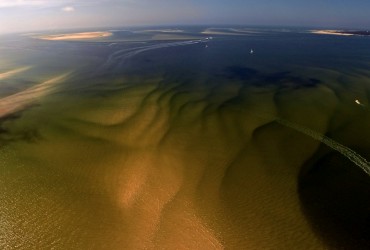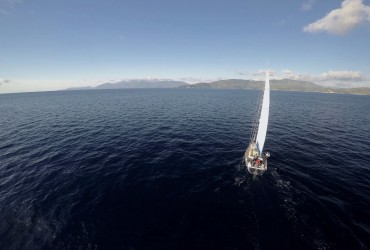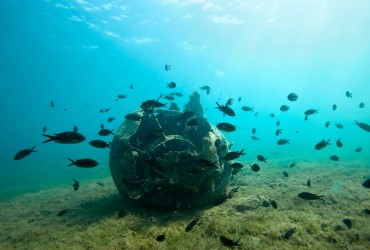Sargassum, resource for the future?
The tropical Atlantic is far from being the only place that is overwhelmed by macro-algae. Take French Polynesia for example, at the heart of the Pacific. Since the 1980s, the islands hosting most of human activity saw their lagoons being taken over by two species of brown seaweed: The Tubinaria Ornate and the Sargassum Pacificum. «My thesis was about Polynesian coral reefs being invaded by seaweed, recalls the French biologist Valérie Stiger-Pouvreau. One of the two species I was studying at the time, the Sargassum Pacificum, is a fixed tropical alga. I tried to understand how this seaweed could replace the corals in an ecosystem. We noticed that as soon as a reef is weakened, macro-algae move in and colonize the bedrock. The Sargassum Pacificum is usually fixed, but it can also float. My theory was that this seaweed used its buoyancy to move around and settle in other archipelagos. Much like what we are witnessing today in the Atlantic with the two species of Sargassum Natans and Fluitans, where rafts of floating seaweed are pushed by currents and trade winds to new lagoons.»
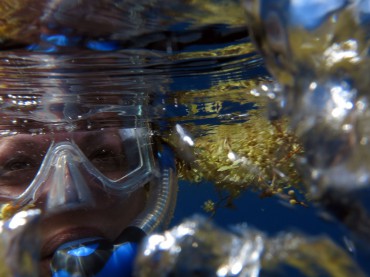 The story has been scripted before. The weakening of the coral systems, the over-fishing of herbivore species, the arrival of nutrient rich waters through rivers bordering hubs of intense human activity. These are all the ingredients to the seaweed proliferation recipe we can observe today. As predicted, the economy is suffering along with the ecology. Whether it happens in the Caribbean, in Polynesia or in Africa, the communities have all worked towards similar responses. The systematic cleaning and picking up of the Sargassum washed on the coasts is believed to limit the spreading. In Polynesia, where this kind of events have been happening for longer, it quickly came as an evidence that these endless piles of seaweed had to be used on an industrial scale. It was the only way to put a stop to the proliferation, and to adapt to this new ecological reality.
The story has been scripted before. The weakening of the coral systems, the over-fishing of herbivore species, the arrival of nutrient rich waters through rivers bordering hubs of intense human activity. These are all the ingredients to the seaweed proliferation recipe we can observe today. As predicted, the economy is suffering along with the ecology. Whether it happens in the Caribbean, in Polynesia or in Africa, the communities have all worked towards similar responses. The systematic cleaning and picking up of the Sargassum washed on the coasts is believed to limit the spreading. In Polynesia, where this kind of events have been happening for longer, it quickly came as an evidence that these endless piles of seaweed had to be used on an industrial scale. It was the only way to put a stop to the proliferation, and to adapt to this new ecological reality.
In October 2015, the diver and researcher Stéphane Jacquet published an article in Subaqua Magazine based on Mayalen Zubia’s work. This marine biology lecturer at the University of French Polynesia has followed up on Valérie Stiger-Pouvreau’s thesis. She was interested in the valorization of the two species of invasive brown seaweed. Stéphane Jacquet explains: «Worldwide, macro-algae are a significant supply source. They are mostly used in agribusiness, and on markets in Asia for human food.» When looking at the list of Western countries that consume seaweed, it’s interesting to see that Brazil is one of them.
According to Mayalen Zubia’s work, the local businesses in Polynesia are mainly interested in the agricultural applications the seaweed can offer. «These macro-algae are rich in minerals, oligo elements, vitamins, polysaccharides and have traces of polyphenols and growth hormones,» writes Stéphane Jacquet. All the ingredients needed for a great compost and fertilizer. Tests are being conducted. According to the diver-researcher, the best solution would be to transform the algae into liquid fertilizer, a high added value product. «These proliferating seaweed can therefore be considered a promising resource for French Polynesia. The harvest would also help slow down the spreading to otherwise untouched zones.»
 Would that be enough to lift the spirits of all these scarred communities in the Gulf of Guinea? Maybe. In any case, this is the path to follow. In Côte d’Ivoire, oceanographer Yacouba Sankaré is confident: «People are already using the Sargassum to make compost. On the scale of a coastal village, it could create jobs, maybe as much as 20 for every factory. This new soil conditioner could be used in every organic farm.» But at the CNRS, Philippe Potin remains cautious: «We have to define what these seaweeds could bring to the islands’ local development and make sure it’s beneficial. We are talking about several years of study, and we are worried that people will start relying on a resource whose periodicity is still unknown.» However, the researcher agrees that in other parts of the world, the washed up seaweeds are already part of the local economy, such as in Brittany where the wrack is harvested.
Would that be enough to lift the spirits of all these scarred communities in the Gulf of Guinea? Maybe. In any case, this is the path to follow. In Côte d’Ivoire, oceanographer Yacouba Sankaré is confident: «People are already using the Sargassum to make compost. On the scale of a coastal village, it could create jobs, maybe as much as 20 for every factory. This new soil conditioner could be used in every organic farm.» But at the CNRS, Philippe Potin remains cautious: «We have to define what these seaweeds could bring to the islands’ local development and make sure it’s beneficial. We are talking about several years of study, and we are worried that people will start relying on a resource whose periodicity is still unknown.» However, the researcher agrees that in other parts of the world, the washed up seaweeds are already part of the local economy, such as in Brittany where the wrack is harvested.
Valérie Stiger-Pouvreau is also convinced that the harvested seaweed could be good business: «The Sargassum is rich in alginic acid and other polysaccharide, and if they are of sufficient quality, they could be used in the agribusiness. Other active molecules could also be interesting for the pharmacology and cosmetic industry.»
As a matter of fact, the Breton company Algopack is producing alternate types of plastic that are all made from brown seaweed. It is currently looking into the Sargassum and how it could be transformed. Even if there seems to be a wide range of uses, they are still all very costly. For example, the harvesting operations are only possible on a large scale. The seaweed needs to be collected at the right time, right before it starts degrading or getting mixed up with sand. It’s therefore better to collect the algae when still floating in the water, where its quality is at its best. The first stage consists of targeting the seaweed sheets with satellite images. Specialists have to predict where it will wash-up, considering the currents, trade winds and coastal topography. Since spring 2015, the French National Center for Space Studies was put in charge of this part of the program by the Minister of Ecology.
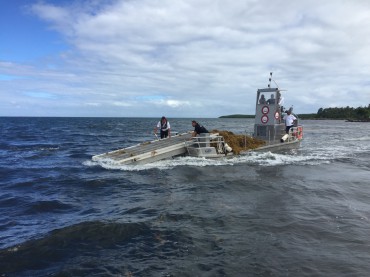 Once the first stage is completed, the adequate tools must be chosen. Many systems have been imagined, like dams and nets, and some have already been tested. In Guadeloupe, the Sargator, a boat equipped with a conveyer belt, has been developed to harvest the seaweed in waters over one-meter deep. Several companies have answered a call for projects launched by the Environmental and Energy Agency (ADAME) in order to find the most effective systems from the Sargassum’s harvest to its valorization. The results have been presented in January 2016.
Once the first stage is completed, the adequate tools must be chosen. Many systems have been imagined, like dams and nets, and some have already been tested. In Guadeloupe, the Sargator, a boat equipped with a conveyer belt, has been developed to harvest the seaweed in waters over one-meter deep. Several companies have answered a call for projects launched by the Environmental and Energy Agency (ADAME) in order to find the most effective systems from the Sargassum’s harvest to its valorization. The results have been presented in January 2016.
Of the 37 proposed projects, 14 have been accepted. «800’000 euros have been allocated to this call for projects, says the biologist Franck Mazéas. They follow the 2 million euros granted in May 2015 by the Minister of Ecology. This public money was used to create the Green Brigade, to test and develop ideas from the call for projects, and for emergency credits for beaches that had been neglected and not cleaned up in a long time.»
Overall, Franck Mazéas is rather optimistic for the future: «We are witnessing real progress, such as better warning systems, wash-up previsions and H2S measuring by the ARS since 2011. Innovative ways of collecting the seaweed out at sea are being developed as we speak, and on land we are working towards cleaning up methods that are more respectful of the fragile environments.» The Sargassum valorization is under way, it’s now a matter of time and money.
All of the specialists we met during this investigation have shown us at least one positive side to this Sargassum problem. Damien Chevallier and his team who study marine turtles plan to use the satellite monitoring of seaweed patches in parallel with the following of turtles equipped with transmitters: «Out at sea, the masses of floating seaweed protect the turtles against a number of threats» he says. And to what extent do these enormous patches of Sargassum influence the animal’s migratory routes? «In the Caribbean, researchers are studying the fauna that lives around the seaweed rafts» he answers. The rafts act as fish aggregating devices (FAD), which is good news for the ecosystem and for the fishermen. Yacouba Sankaré says they are as useful as any artificial reefs: «Apparently, fishermen have been catching tunas around them» he says. In Guadeloupe waters, the dorado population is increasing: «A few years ago, its meat was sold 10 euros a kilo. Now, you can buy 3 kilos of dorado for 20 euros» says the biologist Didier Potin.
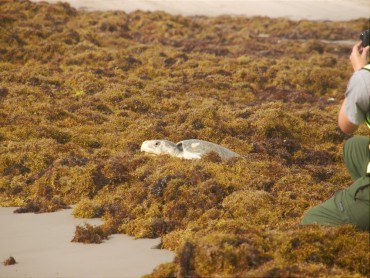 It remains to be seen if the number of species in the Little Sargasso Sea will become as diversified as in the waters of its big sister, north of the Caribbean. Yet, it doesn’t really seem to be the case. For the CNRS researcher Philippe Potin, «the specific biodiversity we can observe off the coast of Brazil, West Africa and America seems less important than the one in the original Sargasso Sea.» Are the floating species that drift along Africa and Brazil really identical to the ones in the Sargasso Sea? They are indeed the same S. Fluitans and S. Natans. But Valérie Stiger-Pouvreau stays cautious: «Morphological studies have confirmed they are of the same species. But it’s not enough. We have to look at the molecular level, because although the characteristics look alike, they can still be genetically different. In which case their behaviors would be different.»
It remains to be seen if the number of species in the Little Sargasso Sea will become as diversified as in the waters of its big sister, north of the Caribbean. Yet, it doesn’t really seem to be the case. For the CNRS researcher Philippe Potin, «the specific biodiversity we can observe off the coast of Brazil, West Africa and America seems less important than the one in the original Sargasso Sea.» Are the floating species that drift along Africa and Brazil really identical to the ones in the Sargasso Sea? They are indeed the same S. Fluitans and S. Natans. But Valérie Stiger-Pouvreau stays cautious: «Morphological studies have confirmed they are of the same species. But it’s not enough. We have to look at the molecular level, because although the characteristics look alike, they can still be genetically different. In which case their behaviors would be different.»
The CNRS researcher, along with her colleagues in Marseille, hope to conduct field studies in 2016. Her fellow researcher Philippe Potin regrets the lack of funding: «The national media wasn’t interested in the Sargassum invasion before 2014… maybe a little more pressure from the media would generate investments.» In the Gulf of Guinea, a group of experts part of the United Nations Environment Programme (UNEP) got together in November 2015 in Sierra Leone to discuss how to deal with the Sargassum invasion. Since the problem is transatlantic, the UNEP plans on tackling the Sargasso issue during the United Nations General Assembly on the environment in May 2016.
In their natural habitat, where they are indispensable, the Sargassum have been threatened for years by anthropogenic activities. However, they became a plague when they started washing up in too many numbers on foreign coasts. Clearly, the Sargassum has two sides to it, and we had to wait to see its ugly face before serious research could reveal its potential. Franck Mazéas concludes: «Important investments are still necessary to understand these large scale episodes, which are still unpredictable. We can even ask ourselves, will they last or disappear altogether? We are still in the dark.»

